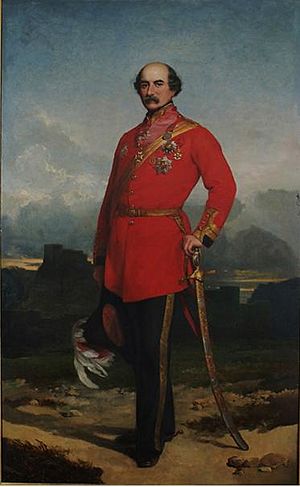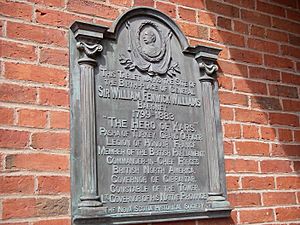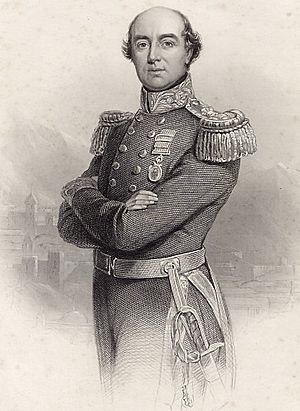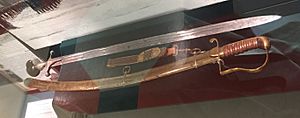Fenwick Williams facts for kids
Quick facts for kids
General the Honourable Sir
Fenwick Williams
|
|
|---|---|

William Fenwick Williams with sword given by Nova Scotia House of Assembly by William Gush, Province House (Nova Scotia) (sword is displayed at University of King's College Library, Halifax)
|
|
| Born | 4 December 1800 Annapolis Royal, Nova Scotia |
| Died | 26 July 1883 (aged 82) London, England, UK |
| Allegiance | |
| Service/ |
|
| Years of service | 1825–1883 |
| Rank | General |
| Commands held | Commander-in-Chief, North America |
| Battles/wars | Crimean War |
| Awards | Knight Grand Cross of the Order of the Bath |
| 1st Lieutenant Governor of Nova Scotia | |
| In office 8 November 1865 – 18 October 1867 |
|
| Monarch | Victoria |
| Governor General | The Viscount Monck |
| Premier | Charles Tupper Hiram Blanchard |
| Preceded by | Charles Hastings Doyle |
| Succeeded by | Charles Hastings Doyle |
General Sir William Fenwick Williams, 1st Baronet (born December 4, 1800 – died July 26, 1883) was an important military leader from Nova Scotia. He served the British during the Victorian era, a time when Queen Victoria ruled.
Williams is best known for his amazing defense of the town of Kars during the Crimean War. He and other British officers inspired Turkish soldiers. These soldiers were not well-equipped, but they fought bravely. They pushed back Russian attacks for three months. The Russians, led by General Murav’ev, suffered 6,000 casualties.
Eventually, the defenders of Kars had to surrender. This was because they ran out of food, got sick, and had no more ammunition. However, they were allowed to surrender on their own terms. This meant the officers could keep their swords, which was a great honor. Williams was held as a prisoner in Ryazan, Russia. He was treated very well and was released when the war ended in 1856. Before he went home, he even met Tsar Alexander II, the Russian emperor.
After the war, Williams received many honors. From 1865 to 1867, he became the first Lieutenant Governor of Nova Scotia, the place where he was born.
Contents
Early Life and Education
William Fenwick Williams was born in Annapolis Royal, Nova Scotia. He was the second son of Thomas Williams, who worked for the military in Halifax.
He went to school at the Royal Military Academy in Woolwich, England. This is a special school for training army officers. In 1825, he joined the Royal Artillery as a second lieutenant.
Military Career
In 1841, Williams was sent to Turkey to help their army. He worked as a captain in the arsenal, which is a place where weapons are stored and made, in Constantinople. He also helped with important meetings. These meetings led to the treaty of Erzurum in 1847. He also helped set the border between the Ottoman Empire and Iran in 1848. In 1852, he was given an award called the CB.
The Crimean War
Williams was promoted to colonel. In 1854, during the Crimean War, he became a British commissioner with the Turkish army. He was made a pasha, which is like a general or governor. He led the Turkish troops defending the town of Kars.
He and other British officers inspired the Turkish soldiers. Even though they didn't have much equipment, they fought off Russian attacks for three months. The Russians, led by General Murav’ev, lost 6,000 soldiers. The defenders of Kars eventually had to surrender. This was because they were starving, sick, and had no more ammunition. But they were allowed to keep their swords, which was a sign of respect. Williams was taken prisoner in Ryazan, Russia. He was treated well and released when the war ended in 1856. He even met the Russian emperor, Tsar Alexander II.
General Murav’ev himself praised Williams's defense of Kars. He said Williams had made a name for himself in history. He was amazed by the courage and discipline of the army during the siege.
Williams received many honors for his bravery. He was made a baronet and given a pension for life. He also received the KCB and other important awards. The City of London gave him the freedom of the City of London and a special sword. Oxford University gave him an honorary degree.
After returning from Russia, Williams was promoted to major-general in November 1855. He was also a member of parliament for the area of Calne from 1856 to 1859. From 1859 to 1864, he was the Commander-in-Chief, North America. This meant he was in charge of British forces in North America. He prepared for possible war with the United States. This was during the time leading up to the American Civil War. He was promoted to lieutenant-general in 1864.
Governorships

Sir William Fenwick Williams served as the governor of Nova Scotia from 1865 to 1867. After Canadian Confederation in 1867, he continued as the first Lieutenant Governor of Nova Scotia. He also served as the governor of Gibraltar from September 1870 to 1876. In 1871, he received another high honor, the GCB. In 1881, he became the Constable of the Tower of London, a very old and important position.
Later Life
Sir William Fenwick Williams passed away in a hotel in Pall Mall, London, on July 26, 1883. He was buried in Brompton Cemetery. A portrait of him, painted by William Gush, hangs in Province House in Halifax, Nova Scotia, to this day.
Legacy
Many places and things are named after Sir William Fenwick Williams:
- Karsdale, Nova Scotia
- The village of Port Williams, Nova Scotia
- The village of Kars, Ontario
- Kars Street in Port Williams, Nova Scotia
- Fenwick Street in Halifax
- Fenwick Tower (Halifax)
- A plaque in Annapolis Royal, Nova Scotia honors his birthplace.
See also




